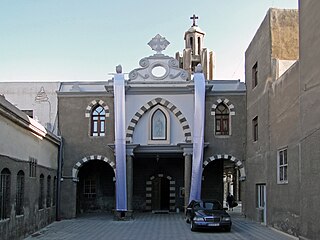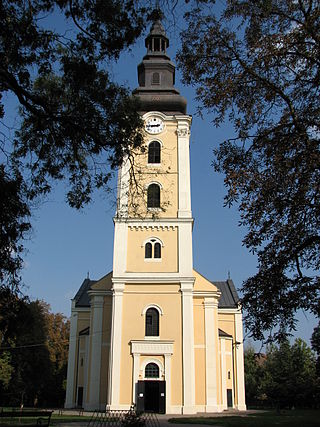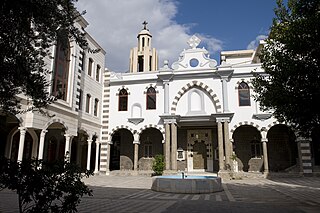
The Syriac Catholic Church is an Eastern Catholic Christian jurisdiction originating in the Levant that uses the West Syriac Rite liturgy and has many practices and rites in common with the Syriac Orthodox Church. Being one of the twenty-three Eastern Catholic Churches, the Syriac Catholic Church is a self-governed sui iuris particular church, while it is in full communion with the Holy See and with the entirety of the Catholic Church.

The Ukrainian Greek Catholic Archeparchy of Philadelphia is a Ukrainian Greek Catholic Church ecclesiastical territory or archeparchy of the Catholic Church in the Eastern United States. Its episcopal see is Philadelphia, Pennsylvania. The Archeparchy of Philadelphia is a metropolitan see with three suffragan eparchies in its ecclesiastical province. The Archeparchy of Philadelphia's territorial jurisdiction includes the District of Columbia, Virginia, Maryland, New Jersey, and the eastern and central portions of Pennsylvania.

The Ethiopian Catholic Church or Ethiopian Eastern Catholic Church is a sui iuris (autonomous) Eastern Catholic church that is based in Ethiopia. As a particular church of the Catholic Church, it is in full communion with the Holy See. Established in 1930, the church is organised under a metropolitan bishop who exercises oversight of a number suffragan dioceses. In its liturgical services, it uses the Alexandrian Rite in the Ge'ez language.

The Hungarian Greek Catholic Church or the Byzantine Catholic Church in Hungary is a sui iuris (autonomous) Eastern Catholic church based in Hungary. As a particular church of the Catholic Church, it is in full communion with the Holy See. Its liturgical usage is that of the Byzantine Rite in the Hungarian language.

The Archeparchy of Winnipeg is a Ukrainian Greek Catholic Church ecclesiastical territory or archeparchy of the Catholic Church in Manitoba, a province of Canada. Currently, its archeparch is Lawrence Huculak.

The Eparchy of Edmonton is a Ukrainian Greek Catholic Church ecclesiastical territory or eparchy of the Catholic Church that governs parishes in the Canadian province of Alberta. It uses the Byzantine Rite liturgy in the Ukrainian language and English language. The eparchy's cathedral is St. Josaphat's Cathedral in the episcopal see of Edmonton, Alberta.

The Ethiopian Catholic Archeparchy of Addis Abeba, officially the Metropolitan sui iuris Archeparchy of Addis Abeba is the metropolitan see of the Ethiopian Catholic Church, a sui iuris metropolitan Eastern Catholic Church.

The Archeparchy of Pittsburgh is an archeparchy of the Ruthenian Greek Catholic Church that is located in the southern part of the United States of America. It is part of the Metropolis of Pittsburgh. The geographical remit of the archeparchy includes the states of Alabama, Arkansas, Kentucky, Louisiana, Mississippi, Pennsylvania, Tennessee, Texas, and West Virginia. The incumbent archeparch is the Most Reverend William C. Skurla. The episcopal seat is situated in the city of Pittsburgh.

The Archeparchy of Hajdúdorog is an archeparchy of the Hungarian Greek Catholic Church which is an Eastern Catholic particular church of the Catholic Church that is in full communion with the Holy See. The archeparchy is the metropolitan see of its ecclesiastical province which covers the whole of Hungary. The archeparch is also, ex officio, the metropolitan bishop of the metropolis. The cathedral church of the archeparchy is the Cathedral of the Presentation of Mary in the city of Hajdúdorog.
The Apostolic Vicariate of Beirut is a Latin Church ecclesiastical jurisdiction or apostolic vicariate of the Catholic Church in Lebanon, where Eastern Catholics are far more numerous. In 2010, there were 15,000 baptized. Its current bishop is Cesar Essayan.
Melkite Greek Catholic Archeparchy of Petra and Philadelphia in Amman is a branch of the Melkite Greek Catholic Church immediately subject to the Patriarchate of Antioch of the Melkites. In 2007 there were 27,000 baptized. Joseph Gébara was elected Archeparch on February 20, 2018.
The Syriac Catholic Archeparchy of Mosul is a Syriac Catholic Church ecclesiastical territory or archeparchy in northern Iraq. It is not a metropolitan see and is immediately exempt to the Syriac Catholic Patriarch of Antioch and the Roman Congregation for the Oriental Churches, and not part of any ecclesiastical province. Its cathedral is the Syriac Catholic Cathedral in the episcopal see of Mosul.
The Maronite Eparchy of Latakia or Latakia of the Maronites is a Maronite Church ecclesiastical territory or eparchy of the Catholic Church in Syria. As of 2011, there were 35,000 members. The current eparch is Antoine Chbeir.

The Syriac Catholic Archeparchy of Damascus is a Syriac Catholic Church ecclesiastical territory or eparchy of the Catholic Church in Syria. While a metropolitan see, the Archeparchy of Damascus is without suffragans and is exempt directly to the Syriac Catholic Patriarchate of Antioch. It has its cathedral in the archepiscopal see and Syrian national capital Damascus.
The Syriac Catholic Archeparchy of Baghdad is a Syriac Catholic Church ecclesiastical territory or archeparchy of the Catholic Church in Iraq. It is not a metropolitan see and is directly exempt to the Syriac Catholic Patriarch of Antioch, though not part of his or any other ecclesiastical province, and in Rome depends on the Congregation for the Oriental Churches.
The Mission sui iuris of Syria and Cilicia was a Latin Church pre-diocesan missionary jurisdiction of the Catholic Church in the regions of Syria, Iraq and, initially, Anatolia.

The Ruthenian Uniate Church was a particular church of the Catholic Church in the territory of the Polish–Lithuanian Commonwealth. It was created in 1595/1596 by those clergy of the Eastern Orthodox Church who subscribed to the Union of Brest. In the process, they switched their allegiances and jurisdiction from the Ecumenical Patriarchate of Constantinople to the Holy See. It had a single metropolitan territory — the Metropolis of Kiev, Galicia and all Ruthenia. The formation of the church led to a high degree of confrontation among Ruthenians, such as the murder of the hierarch Josaphat Kuntsevych in 1623. Opponents of the union called church members "Uniates" although Catholic documents no longer use the term due to its perceived negative overtones. In 1620, these dissenters erected their own metropolis — the "Metropolis of Kiev, Galicia and all Ruthenia".









